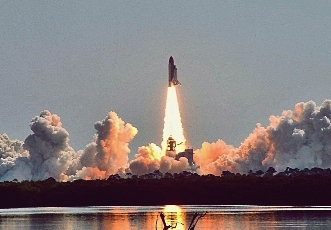
 The U.S. Access to Space.
The STS-114 Space Shuttle flight, seen here launching from Kennedy Space Center's Launch Pad 39B by the end of July 2005, was the famed "Return to Flight Mission", this flight by which the U.S. Space Shuttle was returning to duty. The Space Shuttle program had be halted in February 2003 due to the loss of Shuttle Columbia as she was returning Earth. The STS-114 flight was adhering to the procedures and technical improvements as recommended by an official report. It was unluckily marred back by the recurrent question of the foam debris question. As the loss of Columbia had been found dued to foam debris plumetting from the coating of the External Tank, the new launch kept facing the question. Debris fell during the Shuttle's launch and ascent phases, eventually bringing the Mission Management Team to have astronauts performing work on the underside of the orbiter underside. As another mission was to follow, it had to be postponed until that a definitive and safe approach to the debris question be found. The next flight of the Space Shuttle won't take place now before next July 2006, when the STS-121, 18th ISS Flight (ULF1.1) will launch. The Space Shuttle, in any cas, is to be retired by 2010. At that date, it will be replaced by NASA's next-generation space vehicle, the 'Crew Exploration Vehicle', which will serve to ferry to the ISS and bring man back to Moon, and further to Mars. picture NASA/KSC
The U.S. Access to Space.
The STS-114 Space Shuttle flight, seen here launching from Kennedy Space Center's Launch Pad 39B by the end of July 2005, was the famed "Return to Flight Mission", this flight by which the U.S. Space Shuttle was returning to duty. The Space Shuttle program had be halted in February 2003 due to the loss of Shuttle Columbia as she was returning Earth. The STS-114 flight was adhering to the procedures and technical improvements as recommended by an official report. It was unluckily marred back by the recurrent question of the foam debris question. As the loss of Columbia had been found dued to foam debris plumetting from the coating of the External Tank, the new launch kept facing the question. Debris fell during the Shuttle's launch and ascent phases, eventually bringing the Mission Management Team to have astronauts performing work on the underside of the orbiter underside. As another mission was to follow, it had to be postponed until that a definitive and safe approach to the debris question be found. The next flight of the Space Shuttle won't take place now before next July 2006, when the STS-121, 18th ISS Flight (ULF1.1) will launch. The Space Shuttle, in any cas, is to be retired by 2010. At that date, it will be replaced by NASA's next-generation space vehicle, the 'Crew Exploration Vehicle', which will serve to ferry to the ISS and bring man back to Moon, and further to Mars. picture NASA/KSC
 Image choisie: L'accès américain à l'espace
Image choisie: L'accès américain à l'espace
La mission STS-114 de la navette spatiale s'envole, fin juillet 2005, du pas de lancement 39B du Kennedy Space Center. Cette mission était la "mission de retour au vol" de la navette, dans la mesure où la flotte américaine avait été immobilisée du fait de la perte de la navette Columbia lors du retour de celle-ci sur Terre en février 2003. Le vol STS-114 avait été préparé de telle sorte qu'il respecte les recommendations énoncées par la commission d'enquête officielle. L'enthousiasme du retour à l'espace fut cependant entaché de la question récurrente des débris de mousse du réservoir principal. L'accident de la navette Columbia, en effet, avait été attribué au fait que des débris d'une mousse protectrice étaient tombés au cours du lancement et avaient endommagé l'aile de la navette. Le vol STS-114 fut de nouveau affecté de ces problèmes. La NASA dut finalement décider d'une sortie dans l'espace pour réparer des dommages repérés sous le nez de la navette... La mission qui devait suivre dut, de plus, être repoussée jusqu'à ce qu'une solution définitive et sûre soit trouvée. C'est pourquoi le vol STS-121 ne décollera pas avant juillet prochain (2006). La navette spatiale américaine, de plus, et en tout état de cause, prendra sa retraite en 2010. Le "Crew Exploration Vehicle", le CEV, à cette date, prendra le relais. Le CEV sera le nouveau vaisseau spatial de la NASA. Il servira à desservir la Station Spatiale Internationale, à ramener l'homme sur la Lune et à l'emmener sur Mars. NASA/KSC
Website Manager: G. Guichard, site 'Amateur Astronomy,' http://stars5.6te.net. Page Editor: G. Guichard. last edited: 12/28/2010. contact us at ggwebsites@outlook.com


![]() Image choisie: L'accès américain à l'espace
Image choisie: L'accès américain à l'espace